The Bulletin of Status Quo of Desertification and Sandification in China
Preface
To attain an accurate master of the land desertification and sandification status and dynamic condition in China, the State Forestry Administration in accordance with the Desertification Prevention and Control Law of the People’s Republic of China, the State Council’s Decision of Further Strengthening the Work of Desertification Prevention and Control, carried out the 4thround of national desertification and sandification monitoring from 2009 to 2010 with involvement of experts and technicians from relevant departments and institutions. Totally 250 million sets of data obtained from the 5,920,000 field survey compartments and mapping units, have been consolidated as analytical information elaborating the status and dynamic condition of the desertification and sandification in the country.
The monitoring covers the period from early 2005 to end 2009. It’s results indicate that by the end of 2009, the desertified land area of China was 2,623,700 square kilometers and the sandified land area 1,731,100 square kilometers. Compared with those in 2004, over 5 years the net desertified land area decreased by 12,454 square kilometers with an annual reduction of 2,491 square kilometers while the sandified land net reduction was 8,587 square kilometers with an annual average reduction of 1,717 square kilometers.
The monitoring results indicate that the development process of land desertification and sandification in China has been primarily curbed in general. Desertification and sandification keep falling off by total acreage of but kept expanding in partial locations. This report based on the results of the 4th China National Desertification and Sandification Monitoring briefed the latest information of the desertification and sandification status in China by 2009, in an attempt to inform the public of the current status of desertification and sandification in China, the achievements made and the challenges faced with for enhanced confidence in and support to the work of the desertification prevention and control in China.
Contents
■ Preface
■ Status of Land Desertification and Sandification in China
■ Dynamic Changes of Land Desertification and Sandification
■ Status of Land Most Vulnerable to Sandification
■ General Tendency of Land Desertification and Sandification
■ Cause Analysis of The Continuous Net Reduction of Desertified and Sandified Land
■ Challenges of Desertification and Sandification and Countermeasures
I. STATUS OF LAND DESERTIFICATION [①]AND SANDIFICATION [②] IN CHINA
1. Desertification
By the end of 2009, China had a total desertified land area of 2,623,700 square kilometers making up 27.33% of the national territory and located in 508 counties (banners, county-level cities) of 18 provinces (autonomous regions, municipalities) of Beijing, Tianjin, Hebei, Shanxi, Inner Mongolia, Liaoning, Jilin, Shandong, Henan, Hainan, Sichuan, Yunnan, Tibet, Shaanxi, Gansu, Qinghai, Ningxia and Xinjiang.
(1) Desertification status in different climatic zones. The desertified land area in arid zone was 1,158,600 square kilometers making up 44.16% of the total desertification acreage; The desertified land area in semi-arid zone was 971,600 square kilometers making up 37.03% while desertified land area in the dry sub-humid zone was 493,500 square kilometers or 18.81% of the total (Fig 1-1).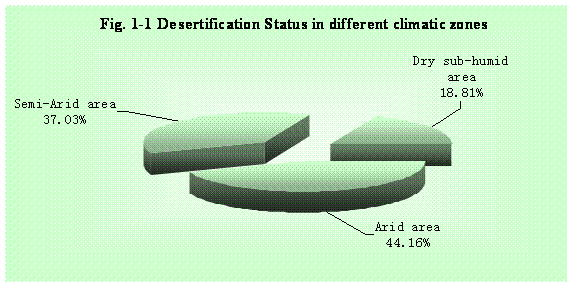
(2) Status of different types of desertification. Desertification caused by wind erosion represented 1,832,000 square kilometers or 69.82% of the total desertified land area; the desertification caused by water erosion 255,200 square kilometers or 9.73%; salinization 173,000 square kilometers or 6.59%; and freeze-thawing desertification 363,500 square kilometers or 13.86% of the total (Fig 1-2).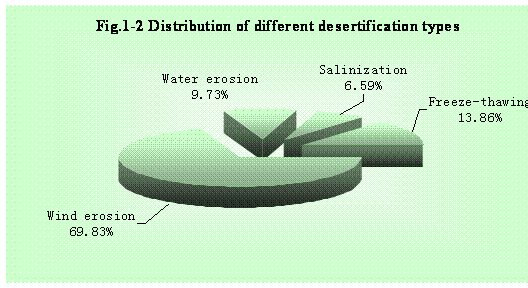
(3) Desertification status in various provinces. Desertification mainly occurred in the 5 provinces (autonomous regions) of Xinjiang, Inner Mongolia, Tibet, Gansu, Qinghai with the desertified land area of 1,071,200 square kilometers, 617,700 square kilometers, 432,700 square kilometers, 192,100 square kilometers and 191,400 square kilometers respectively. The accumulative desertified land area of the 5 provinces (autonomous regions) accounts for 95.48% of the total desertified land in China while the other 13 provinces (autonomous regions, municipalities) for 4.52%(Fig 1-3).
2. Sandification
By the end of 2009, China had a total sandified land area of 1,731,100 square kilometers making up 18.03% of the national territory and located in 902 counties (banners, cities) of the 30 provinces (autonomous regions, municipalities) other than Shanghai, Taiwan, Hong Kong and Macao.
(1) Distribution of different sandification types. The area of shifting sand dunes (lands) was 406,100 square kilometers making up 23.46% of the total sandified land area of the whole country; The area of semi-fixed sand dunes (lands) was 177,200 square kilometers or 10.24%; Fixed sand dunes (lands) 277,900 square kilometers or 16.06%; the area of sandy patch land 99,700 square kilometers or 5.76%; sandified arable land 44,600 square kilometers or 2.58%; wind eroded residual mounds 8,898 square kilometers or 0.51%; wind eroded inferior lands 55,700 square kilometers or 3.22%; Gobi desert 660,800 square kilometers or 38.17%; non-biological treated sandy lands 66 square kilometers (Fig. 1-4).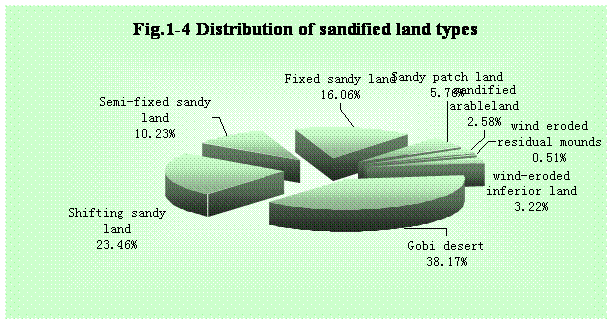
(2) Sandified land distribution in various provinces and autonomous regions. The sandification occurred mainly in the 5 provinces (autonomous regions) of Xinjiang, Inner Mongolia, Tibet, Qinghai, Gansu with the area respectively of 746,700 square kilometers, 414,700 square kilometers, 216,200 square kilometers, 125,000 square kilometers, 119,200 square kilometers. The sandified land area of the 5 provinces (autonomous regions) made up 93.69% of its total of the whole country and the remaining 25 provinces (autonomous regions, municipalities) for 6.31% (Fig 1-5).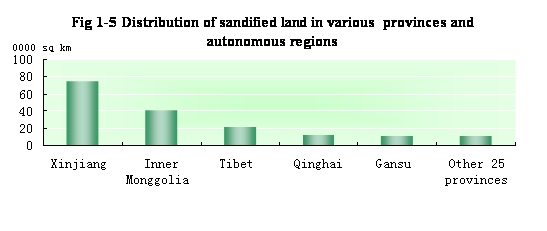
II. DYNAMIC CHANGES OF LAND DESERTIFICATION AND SANDIFICATION
1.Desertification
Compared with 2004, the desertified land area for the whole country dropped by 12,454 square kilometers with an annual reduction of 2,491 square kilometers.
(1) Dynamic changes in terms of different desertification types. Compared with 2004, the area of wind eroded desertified land decreased by 7,391 square kilometers, water eroded desertified land decreased by 4,115 square kilometers, while that of the desertified land caused by salinization decreased by 830 square kilometers and the desertified land caused by freeze-thawing decreased by 118 square kilometers (Fig. 2-1).
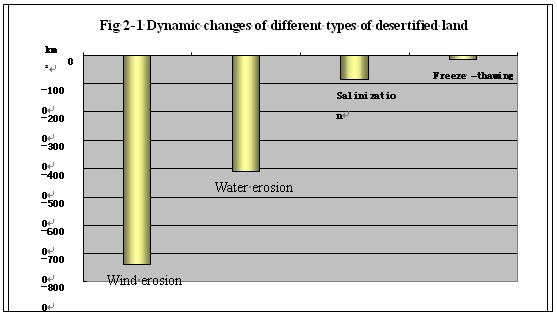
(2)Desertification dynamic changes at provincial level. Compared with 2004, 18 provinces (autonomous regions, municipalities) had net decrease of their desertified land areas, among which Inner Mongolia decreased by 4,672 square kilometers, Hebei by 1,802 square kilometers, Gansu by 1,349 square kilometers, Liaoning by 1,153 square kilometers, Tibet by 789 square kilometers, Ningxia by 757 square kilometers, Shanxi 490 square kilometers, Xinjiang by 423 square kilometers, Shaanxi by 406 square kilometers and Qinghai by 284 square kilometers (Fig. 2-2).
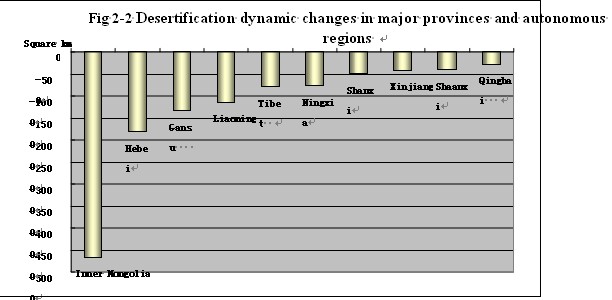
2. Sandification
Compared with 2004, the total sandified land area of China had a net decrease of 8,587 square kilometers with an annual reduction of 1,717 square kilometers.
(1) Dynamic condition of different types of sandified land. Compared with 2004, the shifting sand dunes (lands) decreased by 5,465 square kilometers, semi-fixed dunes (lands) decreased by 1619 square kilometers and fixed sand dunes (lands) increased by 3,271 square kilometers (Fig 2-3).
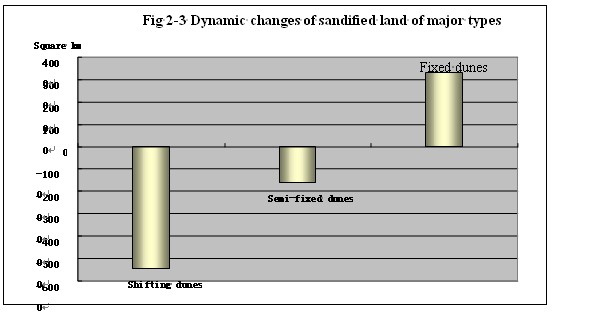
Fig 2-3 Dynamic changes of sandified land of major types
(2) Dynamic condition of sandification in various provinces and autonomous regions. Compared with 2004, most of the provinces (autonomous regions, municipalities) affected had their sandification land areas decreased to different extents, with Hebei by 2782 square kilometers, Inner Mongolia by 1,253 square kilometers, Gansu by 1121 square kilometers, Shanxi by 877 square kilometers, Tibet by 657 square kilometers, Qinghai by 548 square kilometers, Heilongjiang by 330 square kilometers, Shandong by 262 square kilometers, Shaanxi by 212 square kilometers and Ningxia by 204 square kilometers (Fig 2-4).
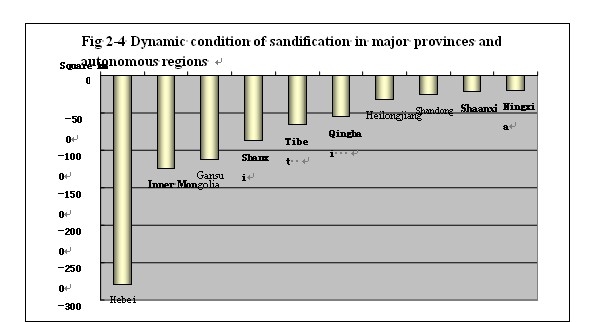
III. STATUS OF LAND most vulnerable to SANDIFICATION
Land most vulnerable to sandification refers to the land with vegetation degradation, productivity reduction and with witnessed shifting sand patch or wind erosion traces on land surface as results of excessive land use and water resource scarcity but no obvious drift sand piles formed. That is, these lands have obvious sandification tendencies although currently they are not sandificated.
1. Present condition of the lands most vulnerable to sandification tendency.
By the end of 2009, China had 311,000 square kilometers of land most vulnerable to sandification comprising 3.24% of total national territorial area. These lands spread mainly in Inner Mongolia, Xinjiang, Qinghai and Gansu provinces (autonomous regions) with respective acreages of 177,900 square kilometers, 47,500 square kilometers, 41,600 square kilometers and 21,800 square kilometers making up accumulatively 92.86% of the total national area of lands most vulnerable to sandification (Fig 3-1 ).
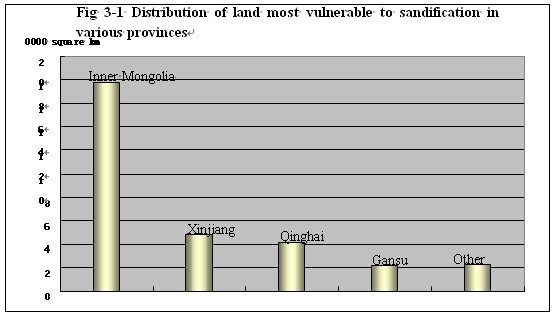
Fig 3-1 Distribution of land most vulnerable to sandification in various provinces
2. The dynamic condition of the lands most vulnerable to sandification
Compared with 2004, the land most vulnerable to sandification in China decreased by 7,608 square kilometers with the annual reduction of 1,522 square kilometers or reduced area of Gansu by 3,989 square kilometers, Inner Mongolia by 2862 square kilometers, Xinjiang by 523 square kilometers, Qinghai by 332 square kilometers, Heilongjiang by 287 square kilometers, Ningxia by 217 square kilometers and Liaoning by 201 square kilometers (Fig 3-2).
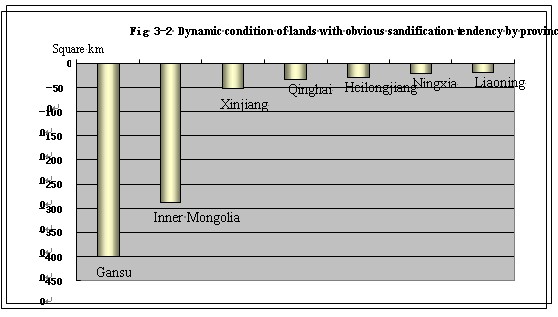
IV.GENERAL TENDENCIES OF LAND DESERTIFICATION AND SANDIFICATION
The monitoring results indicate that the land desertification and sandification have been curbed in general, with a continuous reduction of total area, but expansion in partial locations.
1. The desertified and sandified land areas in continuous reduction.
From 2000 to 2004, the net area of desertified and sandified land decreased annually by 7,585 square kilometers and 1,283 square kilometers respectively, and from 2005 to 2009 decreased annually by 2,491 square kilometers and 1,717 square kilometers respectively.
2. Land desertification and sandification severity in reduction.
Compared with 2004, light desertified land increased by 34,700 square kilometers, moderate desertified land decreased by 16,900 square kilometers, severe desertified land decreased by 6,800 square kilometers, and extreme desertified land decreased by 23,400 square kilometers. Meanwhile, light sandified land increased by 27,300 square kilometers, moderate sandified land dropped by 9,906 square kilometers, severe sandified land dropped by 10,400 square kilometers, extreme sandification declined by 15,600 square kilometers .
3. Vegetation condition in further improvement.
Firstly, the average vegetation coverage of the sandified lands rose from 17.63% in 2004 to 17.03% in 2009 with an increase of 0.60% within 5 years. Secondly, the area of fixed sand land increased while the area of semi-fixed and shifting sand land decreased. Within the 5 years, the fixed sand land increased by 3,271 square kilometers while the shifting sand land decreased by 5,465 square kilometers and semi-fixed sand land decreased by 1,619 square kilometers. Thirdly, the plant diversity increased. In the typical grasslands within the project area of the Beijing-Tianjin Sand Source Combating Program, the plant diversity index was 1.80 in the area to-be-treated but 2.13 in the treated area.
The monitoring indicates that due to the joint impacts of overgrazing, excessive land reclamation, irrational water use and precipitation reduction etc., the regional sandification at highlands of northwest Sichuan, lower reaches of the Tarim River were in expansion although the expansion speed tended to slow down.
V. CAUSE ANALYSIS OF THE CONTINUOUS NET REDUCTION OF DESERTIFIED AND SANDIFIED LAND
The total area of desertified and sandified land in China has been in continuous reduction that is mainly attributed to the following factors: the great attention attached by the central government and series of significant strategic measures adopted, down-to-earth actions taken by the local governments with close coordination among their line agencies and the wide public participation and arduous efforts made by the local people. This also proves that the leadership of the central level plus consistent vigorous inputs made in the work of prevention and control can curb the land desertification and sandification.
1. Strengthened vegetation protection as a fundamental basis of desertification and sandification prevention and control.
By the close observation of the Desertification Prevention and Control Law, the Forest Law, the Grassland Law etc., the “triple prohibitions (i.e., prohibitions of excessive open grazing, excessive land reclamation and excessive firewood collection)” have been carried out widely in affected area that promote vegetations protection effectively.
2. Implementation of ecological projects as the basic channels of improving eco-environmental quality of the affected areas.
During period of the eleventh five-year plan, China implemented a series of ecological improvement programs such as Beijing-Tianjin Sand and Dust Strom Source Combating Project, the Three-north Shelterbelt Forest Construction Project, the Cropland Conversion Project, the Pastureland Conversion Project, the Natural Forest Protection Project, the Grassland Rehabilitation and Conservation Project, the Soil and Water Conservation Project etc. These key projects contributing to desertification control established solid foundation for continuous improvement of the ecological quality in desertification affected areas.
3. Activation of the operational mechanism as impetus to motivate the public participation in sand prevention and control.
The central government promulgated series decisions regarding collective forest tenure reform and enhancing desertification prevention and control etc. arouse enthusiasm of stakeholders participating in desertification control. .
4. Implementation of supporting policies as effective measure to push forward sandification control.
The central government’s compensation or subsidy for the public ecological forest and grassland, some local governments implemented financial subsidization for sand control have played important roles in vegetation recovery and protection. These policies also contributed to livelihood improvement of the farmers and herdsman, promoting restructure of production pattern and alleviating population pressure.
5. Models set up to promote the work of sandification control.
At the National Conference on Desertification Prevention and Control convened in 2007, the premier Wen Jiabao called for the Spirit of Populus euphratica and learning from models to push forward desertification prevention and control. It is the action and spirit of those models including the “sand-combating heroes” of Wang Youde, Shi Guangyin, motivated the local people to engage themselves in the sandification combating work.
In addition, the higher precipitation level in northwest China over the past years promoted to certain extent the vegetation recovery and improvement.
According to the monitoring, the precipitation in northwest China in the past ten years exceeded the normal level. The precipitation in the period of 4th monitoring kept even with that in the last monitoring cycle in most of the northern desertification affected areas and rose only in partial locations. Addition of precipitation made positive contribution to natural vegetation rehabilitation and maintenance of the ecological project implementation achievements.
VI.CHALLENGES OF DESERTIFICATION AND SANDIFICATION AND COUNTERMEASURES
The monitoring results analysis shows that the stern situation of land sandification and desertification in China has not fundamentally changed, and sandification remains the most serious ecological problem of the country, for the following reasons.
1. China is the country with largest area of desertified or sandified lands in the world and 310,000 square kilometers of land most vulnerable to sandification.
2. The sandification of certain areas such as northwest Sichuan, lower reaches of the Tarim River is in expansion.
3. The vegetation in the desertified area in northern China is still in preliminary recovery with weak self regulation capability, poor stability, thus difficult to form steady ecological system in a short period.
4. Negative impacts of human activities on desert vegetation are not at all eliminated. Such irrational practice of overgrazing, unwise reclamation, excessive pick-dig harvesting and irrational water use keep damaging the vegetations.
5. Climate change led to frequent extreme meteorological disasters (such as lasting droughts), which had significant impacts on vegetation establishment and recovery. The danger of land desertification and sandification remains.
The analysis above shows that land desertification and sandification persisted as a serious threat to national ecological security, a restriction to socio-economic sustainable development, a vital livelihood issue and a serious hidden danger to the Chinese nationality. Vigorous efforts, accelerated treatments to desertification and sandification await urgent actions and measures to:
1. Strengthen vegetation protection.
The "triple prohibitions” should be carried out continuously to intensify vegetation protection. Sandified land closure and protected area construction should be conducted in accordance with the law, to enable a full play of the ecosystem resilience to promote natural restoration of desert vegetation;
2. Push forward ecological project implementation.
The implementation of the key projects of desertification prevention and control should be pushed forward to further improve overall layout of the program and enhance the treatment to major sand source areas. Good practices of “operations according to local specific conditions”, “suitable tree species selection for suitable sites ”, “integrated development of vegetation complex of arbors, bushes and grass” etc. should be insisted in vegetation construction for a higher vegetation coverage;
3. Optimize policy mechanism.
The forest tenure reform should be pushed in the desertification affected areas by further clarifying the forest property rights, activating the mechanism and executing the preferential policies. The material incentive principle needs to be followed to mobilize wide participation by combining ecological improvement and income generation, integrating desertification control and poverty alleviation, optimizing supporting policies and actualizing the operational mechanism;
4. Finalize responsibilities.
The government responsibility system of desertification prevention and control should be implemented, and the entity responsibility system of desertification prevention and control should be finalized. The performance assessment and evaluation regulation on desertification prevention and control responsibility of the provincial government should be conducted by delivering reward and punishment;
5. Depend on science and technology advances.
Suitable technologies or operational patterns should be disseminated by reinforcing technical demonstration and training, improving technology application level and raising construction quality;
6. Improve early warning and monitoring.
The monitoring infrastructure construction should be strengthened to establish sound desertification and sandification early warning and monitoring system, and to track the desertification and sandification dynamic on timely basis to provide scientific evidence for decision making and action taking;
7. Strengthen inter-sector cooperation.
Concrete efforts should be made jointly by all relevant departments in desertification prevention and control by means of clarifying roles and responsibilities and advancing close cooperation and collaboration .
--------------------------------------------------------------------------------
[①]The term of desertification in this report refers to land degradation in the arid, semi-arid and dry sub-humid areas as result of various factors including climatic variation and human activities. The degraded lands in these areas are desertified lands.
[②]The sandification in the paper refers to the land degradation characterized by appearance of sand or gravel on ground surface as result of various reasons in all climatic zones. The degraded land with obvious characteristics as above is sandified land.
 0
0 







Go to Forum >>0 Comments